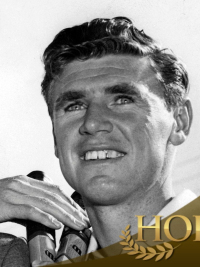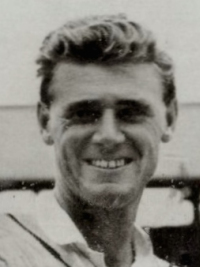Frank Sedgman
Full name: Frank Arthur Sedgman
| Born | October 29, 1927 in Mont Albert, Victoria, Australia |
|---|---|
| Class of HOF | 1979 |
| Height | 5'11" (180 cm) |
| Weight | 150 lbs (68 kg) |
| Plays | Right-handed |
| Bio | He is a retired World No. 1 amateur tennis champion. In his 1979 autobiography Jack Kramer, the long-time tennis promoter and player, included Sedgman in his list of the 21 greatest players of all time. Sedgman is one of only five tennis players all-time to win a multiple slam set in two disciplines, matching Margaret Court, Roy Emerson, Martina Navratilova and Serena Williams. In 1951, he and Ken McGregor won the men's doubles Grand Slam. Sedgman turned professional in 1953. Sedgman led the Australian Davis Cup team to victory in 1950, 1951, and 1952. In a five-year span from 1948 through 1952 Sedgman won 22 Grand Slam titles in singles, doubles, and mixed doubles. Sedgman and his partner Ken McGregor were the only men's doubles team to ever win the Grand Slam in a single year—they won all four majors in 1951. The following year they also won the first three majors, then, at Forest Hills, were upset by a pick-up team of another Australian, Mervyn Rose, and an American Vic Seixas, denying them 8 consecutive Grand Slam victories. According to Rose in a 2005 interview, Harry Hopman, the coach of the Australian team, would not talk to him for two months afterwards. Sedgman was a right-hander who played the serve-and-volley game that had just been popularised by Jack Kramer. He was one of a number of Australian players who used the Continental grip in which the racquet is held the same way for both the forehand and the backhand. He was particularly known for his volleying and speed at the net. When asked in 2005 who was the best player he had ever faced, Mervyn Rose replied, "Hopman's pet, Sedgie." In late 1951, Sedgman was tempted to turn professional for 1952. Harry Hopman, however, led a fund-raising drive via his newspaper column in the Melbourne Herald to keep Sedgman an amateur. Enough money was raised to purchase a gasoline station in the name of Sedgman's future bride. Sedgman remained an amateur for another year but finally turned professional from the start of 1953. Sedgman lost the 1953 World Series tour to Jack Kramer 54 matches to 41. Sedgman was the winner of two major titles in professional tennis, which were the Wembley Pro titles of 1953 and 1958, defeating Gonzales in both tournaments. Sedgman was also the runner-up in four more pro majors in the years before Open tennis. In 1958, Sedgman won his richest tournament, the Sydney Masters, with prize money of 21,000 USD. Sedgman defeated both Gonzales and Trabert in five set matches to win. Kramer designated the Sydney Masters of 1958 as one of the four major professional tournaments. Sedgman also won the Melbourne event in the Ampol world series in January 1959, defeating Gonzales in the final in three straight sets. The match was played outdoors on a fast wooden court. Sedgman won the Grand Prix de Europe tour in 1959, finishing ahead of Rosewall, Hoad, and Trabert. He continued to play professionally until his 1976 retirement. His last appearance in the Australian Championships men's singles in 1976 was 30 years after his first appearance (a record span at Australian championships men's singles). Sedgman was inducted into the International Tennis Hall of Fame in Newport, Rhode Island and was made a Member of the Order of Australia in 1979; in 1985 he was inducted into the Sport Australia Hall of Fame. He received an Australian Sports Medal in 2000. Sedgman was appointed an Officer of the Order of Australia (AO) in the 2019 Queen's Birthday Honours for "distinguished service to tennis as a player at the national and international level, and as a role model for young sportspersons". In his 1979 autobiography Jack Kramer, the long-time tennis promoter and player, included Sedgman in his list of the 21 greatest players of all time. He was five time victor at the Grand Slam events in singles. He carried his country to Davis Cup triumphs for three consecutive years at the start of the 1950s. He had a distinguished professional career across the fifties and on into the sixties. But somehow Sedgman-who was unassailable when he ventured to the net-was never given the acclaim he merited. Self-effacing in the manner of his fellow Australians, Sedgman never boasted about anything he did, and refused at any juncture to be swayed from his altruistic ways. |
| Tournament | AO | RG | W | US | Win-Loss |
|---|---|---|---|---|---|
| 1946 | R16 | A | A | A | 2-1 |
| 1947 | R32 | A | A | A | 0-1 |
| 1948 | QF | R16 | R16 | R16 | 12-4 |
| 1949 | CH | A | QF | QF | 13-2 |
| 1950 | CH | R16 | RU | R16 | 16-3 |
| 1951 | SF | SF | QF | CH | 19-3 |
| 1952 | RU | RU | CH | CH | 25-2 |
| 1953 | A | A | A | A | 0-0 |
| 1954 | A | A | A | A | 0-0 |
| 1955 | A | A | A | A | 0-0 |
| 1956 | A | A | A | A | 0-0 |
| 1957 | A | A | A | A | 0-0 |
| 1958 | A | A | A | A | 0-0 |
| 1959 | A | A | A | A | 0-0 |
| 1960 | A | A | A | A | 0-0 |
| 1961 | A | A | A | A | 0-0 |
| 1962 | A | A | A | A | 0-0 |
| 1963 | A | A | A | A | 0-0 |
| 1964 | A | A | A | A | 0-0 |
| 1965 | A | A | A | A | 0-0 |
| 1966 | A | A | A | A | 0-0 |
| 1967 | A | A | A | A | 0-0 |
| 1968 | A | A | A | A | 0-0 |
| 1969 | A | A | A | A | 0-0 |
| 1970 | R32 | A | A | A | 1-1 |
| 1971 | R32 | R128 | R32 | A | 3-3 |
| 1972 | R16 | A | A | A | 2-1 |
| 1973 | R64 | A | R128 | A | 0-2 |
| 1974 | R64 | A | A | A | 0-1 |
| 1975 | R32 | A | A | A | 1-1 |
| 1976 | R32 | A | A | A | 1-1 |
| Win-Loss | 30-12 | 17-5 | 26-6 | 22-3 | 95-26 |



